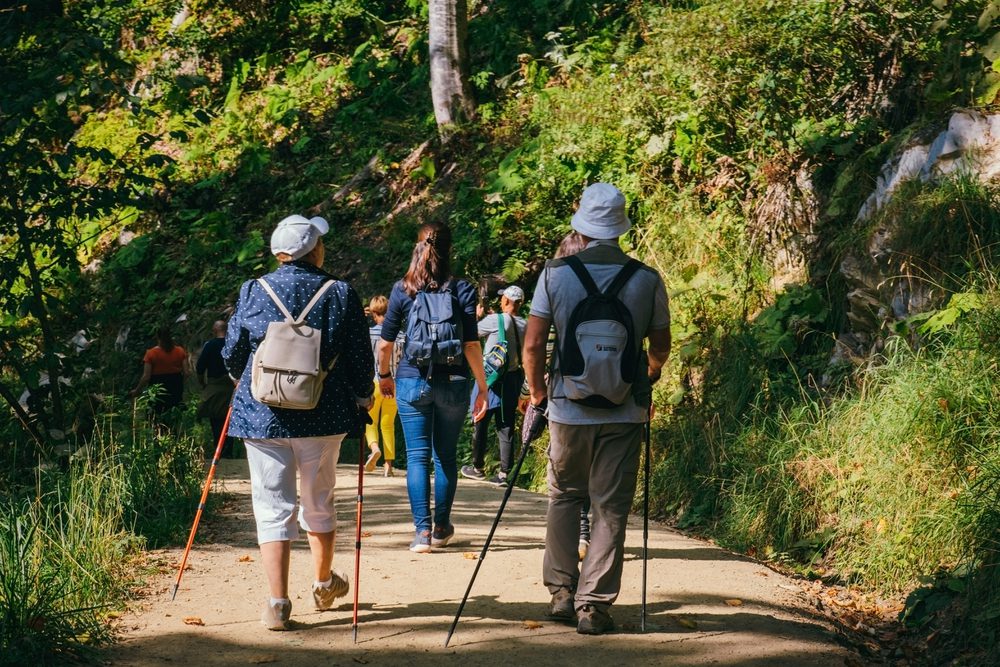With the proper preparation and mindset, travel after retirement can be one of the best chapters of life. Below are over 60 senior travel tips to help you plan, pack, stay safe and healthy, and enjoy your adventures.
Traveling after retirement isn’t just a luxury; it’s a chance to explore, learn, and thrive during your golden years. Studies show that staying active—both physically and mentally—keeps aging travelers healthier and more fulfilled. Whether sipping coffee at a Parisian café, walking through ancient ruins, hiking in the Blue Ridge Mountains, or mingling with locals in a bustling market, travel keeps the mind sharp and the spirit young.

Senior Travel Tips: The Planning Stage
Planning a trip is an exciting experience; travel becomes even more enjoyable and stress-free with the proper preparation. Here are ten essential travel tips for senior travelers to ensure a smooth and memorable adventure. Planning is the backbone of a successful trip. From picking the perfect destination to organizing itineraries, these tips ensure your travels start on the right foot.
1. Pick Destinations with Senior-Friendly Features
Choose destinations that cater to your comfort and needs. Look for places with accessible accommodations, gentle terrains, and senior-specific amenities. River cruises, historic cities, or serene coastal towns are excellent options. These destinations often have easy navigation, guided tours, and relaxing exploring opportunities. Having senior-friendly features will enhance your travel experience and allow you to enjoy your trip without unnecessary inconveniences.
2. Research and Plan Your Itinerary Carefully
Plan an itinerary that balances exploration and relaxation. Research your destination to discover must-see attractions, local eateries, and cultural highlights. Avoid jam-packing your schedule—including downtime to rest and recharge. Consider the time required for activities and transportation to prevent feeling rushed. A well-thought-out plan ensures you can enjoy every moment of your trip without feeling overwhelmed.
3. Consult with a Doctor Before Traveling
Before setting off, visit your healthcare provider to discuss your travel plans. Ensure you’re fit to travel, review your medications, and check if any vaccinations are needed. Share details about your destination, including the climate and activities, so your doctor can provide tailored advice for a safe trip. This step ensures peace of mind and prepares you to handle health concerns while traveling.
4. Pack Medications and Health Essentials
Create a checklist to ensure you’re bringing all necessary medications. Pack them in their original containers with prescription labels, and keep a list of generic names for reference. Include basic health essentials in a DIY travel First Aid Kit, like band-aids, pain relievers, and travel-size first aid supplies. Always pack enough for the trip duration, with some extra in case of delays, and store them in your carry-on for easy access.
5. Purchase Travel Insurance
Invest in travel insurance that covers medical emergencies, trip cancellations, and lost baggage. Having coverage ensures you’re financially protected if unexpected events disrupt your plans. Choose a policy that suits your needs, including health-related coverage tailored to seniors. Travel insurance offers peace of mind and lets you enjoy your trip without worrying about the “what-ifs.”

6. Stay Hydrated and Eat Healthy
Proper hydration and a balanced diet are crucial for energy levels and well-being. Carry a reusable water bottle to stay hydrated, especially during flights and outdoor adventures. Choose nutritious meals and snacks that fuel your activities and promote health. Limit caffeine and alcohol, as they can cause dehydration. Taking care of your nutritional needs will keep you feeling great while traveling.
7. Choose Suitable Accommodations
Always prioritize comfort when selecting accommodations. Look for accessible properties with features like elevators, walk-in showers, and proximity to amenities such as dining options or medical facilities. Call ahead to ensure your needs are met and request accessible rooms, if necessary. Comfortable and senior-friendly lodging will ensure a stress-free and relaxing stay.
8. Be Mindful of Physical Limitations
When planning activities, keep your physical limits in mind. Opt for experiences that align with your fitness level and avoid high-altitude or strenuous excursions that might cause fatigue. Take advantage of guided tours or transportation options like trams to enjoy sights without extra effort. Respecting your limits will make your experience more enjoyable and safe.
9. Pack Comfortable Footwear
Suitable footwear is a travel essential. Bring sturdy, supportive shoes designed for walking and exploring, as they’ll keep your feet comfortable during long sightseeing days. Look for styles with cushioned soles, proper arch support, and breathable materials. Comfortable footwear will reduce fatigue, prevent foot pain, and ensure you stay active throughout your trip.

10. Keep Emergency Information Handy
Prepare a list of important details, including your medical history, prescription information, emergency contacts, and insurance documents. Carry both physical and digital copies with you. It’s also helpful to save local emergency numbers and the address of nearby hospitals. Having this information accessible ensures you’re prepared for any unexpected situations during your travels.
Traveling as a senior opens doors to incredible experiences and cherished memories. With these tips, your journeys will be filled with comfort and safety.
Essential Packing Tips for Senior Travelers
Traveling can be one of the most fulfilling experiences of your golden years, but ensuring that you’re well-prepared can make all the difference. Packing thoughtfully and efficiently reduces stress and sets the stage for a worry-free adventure. Packing can make or break your travel experience. With efficient and thoughtful packing, you will be prepared no matter what.
If you’re a mature explorer ready to head off on your next trip—or even if you’re just starting to plan—these senior packing tips will make your travels smoother and more enjoyable.
11. Start with a Senior-Friendly Packing Checklist
Even the best travelers can forget essentials. Packing checklists designed explicitly for senior travelers can ensure you don’t leave any must-have items behind. You can find printable versions online or use packing apps like PackPoint to customize lists based on your destination and planned activities.
12. Choose Lightweight, Easy-to-Manage Luggage
Since lugging around heavy baggage is no fun (and less feasible for seniors), invest in lightweight but durable luggage, ideally with easy-glide wheels and telescoping handles. Look for lightweight, spinner suitcases that allow effortless movement in any direction. Brands like Samsonite or Travelpro offer sturdy options designed with senior travelers in mind.

13. Use Compression Packing Cubes
Compression packing cubes maximize space and keep luggage organized. They allow you to pack your clothing more compactly while keeping everything neat and easy to find—no more digging for that missing sock. They’re also perfect for dividing outfits by day or activity, further simplifying your trip. Packing cubes make unpacking easy when you arrive at your destination. Just remove it from the suitcase and place it directly into the dresser drawer.
14. Pack Medications Thoughtfully
Medication is non-negotiable, so it needs special attention. Ensure you bring enough for your entire trip (plus a little extra in case of delays). Keep your medications in their original packaging and pack them in your carry-on to comply with TSA guidelines and ensure easy access. A portable pill organizer with alarms or reminders can help you stay on schedule.
15. Layer, Don’t Overpack
Weather can be unpredictable, so pack versatile clothing that can be layered. For instance, a lightweight sweater, comfortable jacket, or scarf can adapt to changing climates. Aim for breathable, wrinkle-resistant fabrics, and stick to a color palette so everything mixes and matches effortlessly. Packing fewer items that can double for multiple occasions helps keep your luggage light.
16. Consider Mobility Aids & Comfort Items
If you use mobility aids—like a cane, walker, trekking poles, or wheelchair—plan how to store or manage them during travel. Many airlines and destinations offer assistance, so call ahead to confirm arrangements. Don’t forget to pack small comfort items like a travel pillow, lumbar support cushion, or temperature-regulating blanket.

17. Bundle Essential Documents in a Travel Folder
Organizing your essentials is key to smooth travel. Pack an organizer or folder for your passport, driver’s license, medical insurance card, prescriptions, travel insurance information, and boarding passes. A slim, zipped travel wallet can provide quick access without fumbling through your bag.
Bonus senior travel tip: Keep digital copies of these documents on your phone or tablet in case the originals get misplaced.
18. Plan for Snacks and Hydration
Long journeys can leave you hungry or dehydrated. Pack healthy snacks like nuts, granola bars, or dried fruit to keep your energy up. Reusable, collapsible water bottles are ideal since they save space when not in use and can be refilled at hydration stations throughout your travels.
19. Stay Connected with Travel Apps and Communities
Technology can be your best travel companion. Apps like TripIt help you manage itineraries, while others, like Medisafe, remind you of medication schedules. Consider joining online senior travel forums to exchange tips and connect with other like-minded adventurers—it’s a great way to prepare and find hidden gems.
20. Give Yourself Time to Pack (and Unpack)
Start early to take the stress out of packing. Begin assembling items a few days in advance, so you have time to revisit your list and adjust without rushing. Similarly, unpacking upon arrival is essential—organizing medications, setting up your essentials, and hanging key items helps you settle quickly and comfortably.
21. Pack Light but Smart
Regarding packing, less is more—but don’t sacrifice essentials. Select a week’s worth of versatile, comfortable clothing in neutral tones for easy outfit combinations. Invest in lightweight luggage with smooth wheels to make navigating airports easier.
Include compression socks for long flights, a compact first-aid kit, and a day bag for excursions. You’ll thank yourself when your suitcase zips effortlessly and your back remains strain-free.
22. Keep Electronics Simple
While smartphones and tablets make travel easier, overpacking tech can be overwhelming. Choose a lightweight device for browsing and communication, and keep chargers in a compact bag. iPads are perfect for travel; they are compact and convenient.
Packing for a trip as a senior traveler doesn’t have to feel overwhelming. With proper planning, smart tools, and focusing on your specific needs, you can set off on your adventure feeling confident and prepared.
Safety Senior Travel Tips
Traveling can be an enriching experience at any age, but it often presents unique challenges for senior travelers. Here are ten practical safety tips to ensure a safe, enjoyable, and stress-free adventure.
Staying safe and secure during your travels ensures peace of mind. These safety-focused tips help senior travelers avoid risks while enjoying new landscapes.
23. Consider Staying in Centrally-Located Accommodations
Choose accommodations in safe, central neighborhoods. Verify location reviews online using platforms like Airbnb or Booking.com. Central locations often keep you closer to medical, transport, and emergency services.
If traveling alone, inform someone of your daily schedule, ensuring enjoyment and security.

24. Protect Valuables the Smart Way
Avoid flashy jewelry or overpacking cash. Instead, opt for travel wallets and money belts for essentials like passports and emergency currency. Lock suitcases and carry only copies of sensitive documents.
25. Pack and Organize Medications Properly
Ensure all necessary medications are packed in original containers to avoid confusion or airport security issues. Carry a detailed list of your medications, including the generic names, and bring extra doses, if permissible, in case of delays. This preparation helps in emergencies, ensuring you can easily replace or explain your prescriptions to healthcare providers overseas. A pill organizer can help manage daily doses without hassle. Keep medications in your carry-on—never check them in with luggage—to ensure immediate access during flights or layovers.
26. Stay Up-to-Date on Vaccinations
Depending on your destination, you may need vaccinations to prevent diseases specific to that region, especially for international travel or cruises. Visit your healthcare provider or local travel clinic well in advance to determine vaccine requirements. Some cruises and travel destinations may also require proof of vaccination for entry. Staying vaccinated is about protecting your health and ensuring a worry-free trip. Keep records of your vaccinations in digital and print formats, ensuring they’re accessible wherever you go.
27. Carry Medical Alert Information
Travel with a medical alert card or bracelet that notes chronic conditions, allergies, or critical health information. These details can help first responders provide appropriate care during emergencies. For example, stating a penicillin allergy could prevent inappropriate treatment. Technology-savvy travelers can use digital medical alert apps with QR codes to share information abroad conveniently. Doing this prepares you no matter where you travel—even in non-English-speaking destinations.
28. Hydrate, Hydrate, Hydrate
Travel often involves unpredictable schedules and climate changes, putting seniors at higher risk of dehydration. Carry a refillable water bottle and track your water intake throughout the day, especially in warm climates or during lengthy sightseeing tours. Be mindful of beverages like alcohol and caffeine, which can dehydrate the body. Some destinations may require caution with tap water—opt for bottled or filtered water when necessary. Proper hydration helps avoid fatigue, dizziness, muscle cramps, and other dehydration-related issues.

29. Plan for Rest Breaks
Sightseeing and long travel days can take a toll. Schedule breaks into your itinerary to preserve your energy. Whether you’re strolling through Central Park in New York City or touring Boston’s historic Freedom Trail, plan short pauses to sit, hydrate, and relax. If road-tripping, map out frequent stops to stretch your legs and reduce fatigue. Rest breaks aren’t just physically beneficial; they allow you to absorb and appreciate your surroundings fully. Strike a balance between adventure and self-care for a more enjoyable experience.
30. Research Medical Facilities at Your Destination
Before arriving at your destination, note nearby hospitals, clinics, or pharmacies. If medical assistance is needed, understanding your healthcare options upfront offers peace of mind. Additionally, always travel with comprehensive travel insurance that covers emergency medical expenses. This is especially important for cruises or international trips where healthcare access may be limited. Carry a copy of your insurance policy and the provider’s contact details for hassle-free emergency assistance.
31. Practice Good Hygiene
Maintaining proper hygiene can drastically reduce your chances of falling ill while traveling. Wash your hands frequently with soap and water, or use hand sanitizer if sinks aren’t accessible. Bring disinfecting wipes to clean high-contact surfaces like airplane trays or hotel remote controls. When eating out, follow common safety recommendations like avoiding raw or undercooked foods and ensuring that food is fresh and warm. These simple precautions go a long way in keeping you healthy throughout your trip.

32. Be Careful with Food and Water
Food and water safety is crucial, particularly in regions with questionable sanitation standards. Stick to bottled water, and when in doubt, avoid ice cubes and raw foods like salads or unpeeled fruits. Prioritize dining at reputable establishments and steer clear of street vendors unless their food preparation appears clean and hygienic. For cruises or retirement communities, ensure that buffet items are served fresh and well-covered. These precautions will protect you from digestive issues, allowing you to focus on the adventure ahead.
33. Wear Proper Footwear & Use Mobility Aids
Comfortable, supportive footwear is essential for safe exploration. Err on the side of caution with closed-toe shoes that provide grip and cushioning, ideal for uneven surfaces or long walking tours. If you require mobility aids, such as walking canes or trekking poles, bring them along and ensure they’re travel-friendly. Proper gear reduces the risk of falls and improves stamina for extended exploration. From climbing cobbled streets in Boston to navigating cruise decks, the right footwear and support gear can make all the difference.
34. Consult Your Healthcare Provider Before Travel
Before planning your trip, visit your healthcare provider to discuss your health and fitness for travel. They can suggest personalized recommendations, such as adapting medications for different time zones, tips for managing chronic conditions abroad, or pre-trip vaccinations. Be honest about your physical limitations and seek advice on mitigating challenges during travel. This proactive step ensures your travel plans align with your overall health, giving you and your loved ones peace of mind.
These precautions allow senior travelers to explore new horizons while staying safe and healthy. Whether cruising the oceans, exploring historical landmarks, or embarking on a road trip, these tips encourage careful preparation and allow you to enjoy the adventure ahead fully.
How to Stay Healthy While Traveling
Traveling is one of life’s great joys, and with a bit of planning, it can remain a healthy and enriching experience. Here are ten senior travel tips to help prioritize well-being wherever your adventures take you.
35. Pack a DIY Travel First Aid Kit
Pack a DIY travel first aid kit to stay prepared and safe while on the go. This kit is essential for senior travelers, helping them handle minor health issues and enjoy peace of mind wherever their adventures take them. When you’re away from home, access to medical supplies and healthcare can be limited. A DIY travel first aid kit allows you to handle minor injuries and illnesses, providing comfort and safety for your family.

36. Carry a Medication Checklist
Create a list of your medications, doses, and schedules. Pack extras in case of delays and keep them in labeled bottles for customs compliance. Consider a compact pill organizer to simplify your routine. With careful preparation, health concerns don’t have to get in the way of adventure.
37. Stay Hydrated and Healthy
Long flights and busy travel days can dehydrate you. Bring a collapsible water bottle to refill throughout the day and snack on hydrating fruits or vegetables. Staying hydrated also helps reduce jet lag and boosts energy.
38. Manage Medications with Care
Carry an ample supply of your medications in their original labeled containers and a copy of your prescriptions. Create a detailed list of the medications you use, including dosages and times, and keep it handy. Research local pharmacy options at your destination in case you need a refill. If traveling across time zones, adjust your medication schedule appropriately—consult your doctor or pharmacist if unsure. Use a pill organizer to keep track of your daily doses and set reminders to avoid missing any medication while enjoying your trip.
39. Be Mindful of Mobility and Prevent Falls
Choose accommodations with elevators or ground-floor rooms to minimize the need for stairs. If you’re exploring destinations like cultural heritage sites, be cautious on uneven terrain and use railing supports when available. Don’t hesitate to use walking aids—many options are lightweight and travel-friendly. Take frequent walking breaks and wear comfortable, supportive shoes to reduce strain. Be aware of your physical limits and avoid overexertion to ensure your travels remain safe and enjoyable.
40. Protect Yourself from the Sun
Sunscreen is your best friend during outdoor adventures. Choose one with SPF 30 or higher, and remember to reapply every two hours. Wear a wide-brimmed hat, sunglasses with UV protection, and lightweight, breathable clothing that covers your skin. Whether hiking the Blue Ridge Mountains or strolling along the beach, these measures protect you from harmful UV rays. Plan outdoor activities during cooler morning or evening hours to avoid the harsh midday sun and reduce the risk of heat-related illnesses.

41. Prioritize Healthy Nutrition
Maintaining a well-rounded diet while traveling is key to staying energized and healthy. Include plenty of fruits, vegetables, lean proteins, and whole grains. Pack healthy snacks like nuts, trail mixes, or protein bars for days of exploring for long periods. Be cautious with street food or unfamiliar dishes, and avoid overeating to prevent digestive discomfort. Research restaurants and menu options in advance for those with dietary restrictions to ensure easily accessible, suitable meals during your travels.
42. Stay Hydrated
Dehydration can sneak up quickly during busy travel, especially in hot or high-altitude destinations. Aim to drink at least 8-10 cups of water daily and carry a refillable, insulated water bottle everywhere you go. Avoid excessive caffeine or alcohol—they can worsen dehydration. Consider electrolyte packets if you spend extended time outdoors or sweat more than usual. Set alarms or reminders to sip water regularly, as it’s easy to forget when you’re immersed in discovering new places.
43. Dress Comfortably for the Destination
Different destinations require varied wardrobe choices, but comfort should always be a priority. Invest in lightweight, moisture-wicking fabrics that keep you cool in warmer climates or slightly insulated layers for cooler weather. Compression socks can be helpful on long flights or bus rides to prevent swelling and improve circulation. If you’re visiting cultural heritage sites, opt for supportive walking shoes to explore paths and stairways comfortably. Practical clothing choices keep you relaxed and ready for adventure.
44. Prepare for Altitude and Fresh Air Challenges
If you’re heading to destinations at higher elevations, like mountain retreats or hiking areas, take steps to acclimate to the altitude gradually. Rest on the first day and stay hydrated to reduce the risk of altitude sickness. For those with respiratory conditions, carry prescribed inhalers and avoid strenuous activities until you’re comfortable with the environment. Research air quality conditions at your destination and consider a lightweight mask if pollution is an issue.

45. Create a Restful Sleep Routine
Good sleep is essential for maintaining energy and recovering after long travel days. Combat jet lag by gradually adjusting your sleep schedule before departure. Bring along sleeping aids like an eye mask, noise-canceling headphones, or your favorite pillow to create a cozy sleep environment wherever you are. If you’re staying at locations with noisy surroundings, consider white noise apps or earplugs. Stick to a relaxing nighttime routine like reading or meditating, ensuring a restful end to each fulfilling day.
46. Focus on Emotional Well-being
Travel can sometimes feel overwhelming, especially when dealing with delays or unfamiliar surroundings. Take time to relax and recharge—whether with a cup of coffee at a local café or a quiet moment of reflection in nature. Seek connection with other travelers or join group tours to alleviate loneliness. Keep in touch with family or friends back home for a boost of familiarity and comfort. Journaling your travel highlights can also bring a sense of fulfillment and joy.
47. Research Local Healthcare Options
Before departure, familiarize yourself with healthcare facilities at your destination. Check if your health insurance covers international or out-of-state travel, and consider purchasing travel insurance if needed. Download helpful apps that include maps to nearby clinics or hospitals in case of emergencies. Carry basic first aid supplies, including bandages, antiseptic wipes, and allergy medications. Knowing where to seek medical help can bring peace of mind, allowing you to immerse yourself fully in the travel experience.
By following these health tips, senior travelers can prioritize well-being while creating unforgettable experiences. Remember, good health is the foundation of every great adventure. Wherever your next destination may be, take care of yourself, stay safe, and savor every moment.
Traveler’s Insurance
Insurance might seem unnecessary—until it’s not. A reliable plan guarantees peace of mind for aging travelers navigating health risks or unexpected events. A top senior travel tip is to consider Traveler’s Insurance.
48. Don’t Skip Travel Insurance
Travel insurance is non-negotiable for senior travelers. It covers medical emergencies, cancellations, and lost luggage. Opt for policies with comprehensive health coverage, especially if visiting destinations where care is expensive.
Wellness Travel Tips
Traveling should rejuvenate the soul, not exhaust the body. It’s not just about the sights; it’s about feeling your best to enjoy them to the fullest. Whether you’re an adventure enthusiast or prefer slow exploration, incorporating these wellness senior travel tips into your vacation can ensure a fulfilling and comfortable experience. Here’s how to stay healthy and stress-free while making the most of your travels.
49. Plan Down Days and Down Time.
Don’t over-schedule your trip. Plan resting days between busy excursions to recharge. Visit a spa, read by the hotel pool, or enjoy a leisurely breakfast with a view. Sometimes luxury is found in those little quiet and peaceful moments.
50. Prioritize Comfortable Travel Routes
Choose direct flights or comfortable train journeys to avoid fatigue and physical strain. Taking the path of least resistance isn’t just about convenience—it’s about saving energy to enjoy your destination. Direct routes or slower-paced train journeys can help minimize travel fatigue for a smoother start to your adventures.
51. Engage in Daily Stretching
Include gentle stretching exercises daily to prevent stiffness and maintain flexibility. Daily stretching or practicing yoga is a simple, powerful way to stay limber during your travels. Focusing on stretches for your back, legs, and shoulders ensures you’re ready for long walks or hours of sightseeing.

52. Explore at Your Own Pace
Avoid rushing and enjoy destinations at a speed that feels right for you.
Travel is a personal experience, and going slow is perfectly fine. Explore in a way that makes you happy, whether strolls or long cafe breaks.
53. Incorporate Mindfulness into Your Day
Practice meditation or deep breathing to stay grounded and reduce stress. A few moments of mindfulness can help you make the most of each day. This simple habit may help you stay centered and energized to explore the serene landscapes. Whether it’s meditation, journaling, or breathwork, grounding practices can set a positive tone for your travels.
Wellness is an essential part of traveling—especially for senior adventurers. By incorporating these tips, you can enjoy your trips to the fullest while prioritizing your health and comfort. Whether stretching in a foreign city, sipping on water mid-hike, or spending an afternoon in peaceful mindfulness, every step you take for wellness will enrich your travels.
Top Senior-Friendly Travel Destinations
Here’s a curated list of travel destinations that cater to cultural enthusiasts, leisure travelers, and nature lovers and offer comfort, relaxation, and adventure.
54. Try River Cruises for Effortless Exploration
River cruises are perfect for seniors—they’re low-effort, scenic, and packed with excursions. Options like the Danube or Mekong offer cultural immersion with all the comforts at hand. It’s like seeing the world from your living room but with different, breathtaking views daily.
River cruises eliminate the hassle of constant packing and transportation. You simply unpack once, relax, and enjoy the ride.
55. Paris, France
Paris is a dream destination for senior travelers, combining charm and history with accessibility. Explore the Eiffel Tower, the Louvre Museum, or Notre Dame Cathedral at your own pace. Leisurely strolls along the Seine River or afternoons at quaint sidewalk cafés provide the perfect opportunity to soak in the city’s ambiance. With excellent public transportation and senior-friendly services, Paris is easy to explore. Don’t miss a gentle cruise along the Seine for picturesque city views. For history buffs, guided tours of Versailles or Montmartre make amazing half-day options while keeping activities relaxed.

56. Kyoto, Japan
Kyoto offers seniors a serene escape steeped in tradition. Visit stunning temples, like the Golden Pavilion or Kiyomizu-dera, or unwind in Kyoto’s tranquil gardens, including the iconic Arashiyama Bamboo Grove. For cultural enthusiasts, tea ceremonies and kaiseki dining provide insight into Japan’s artistry and flavors. The city is pedestrian-friendly, with plenty of resting places, and public transportation is comfortably accessible. Cherry blossom season (spring) and autumn foliage provide breathtaking scenery for photographers and nature lovers alike. Kyoto takes relaxation to the next level—don’t miss a soothing soak in a traditional onsen (hot spring).
57. US National Parks
US National Parks invite seniors to reconnect with nature from Yellowstone to the Grand Canyon. With accessible trails and viewpoints, these parks offer awe-inspiring landscapes and easy opportunities to spot diverse wildlife. Many parks provide senior discounts for entrance fees or even guided tours for leisurely exploration. Consider a scenic drive through Yosemite, a train ride to explore Glacier National Park or even a hot air balloon ride near the Grand Canyon. For outdoor enthusiasts, slow-paced hiking trails and plenty of visitor centers make the parks both educational and enjoyable without being overly strenuous.
58. European River Cruises
A European river cruise is perfect for exploring multiple destinations without the hassle of packing and unpacking. Unwind in luxurious comfort as you cruise scenic waterways like the Seine, Danube, or Rhine. These all-inclusive cruises offer gourmet meals, cultural performances, and guided shore excursions tailored for a slower pace. Stops often include charming villages, historic landmarks, and cultural highlights, from Vienna’s opera houses to Amsterdam’s iconic canals. With accessible cabins and relaxation-focused amenities, these cruises are ideal for travelers seeking adventure and ease. Sit back, sip wine, and take in the surroundings.
59. Caribbean Islands
For seniors seeking relaxation, the Caribbean provides the ultimate sunny escape: picture white sandy beaches, turquoise waters, and waves rolling in. All-inclusive resorts often cater to seniors with activities like aqua aerobics, yoga on the beach, or group dining. Enjoy snorkeling among colorful fish, joining a sailing tour, or taking a gentle stroll along the shore. With mild temperatures and plenty of accessible accommodations, the islands ensure comfort and rejuvenation. Popular options like Jamaica, Barbados, Puerto Rico, and Aruba combine natural beauty with a laid-back, carefree vibe perfect for unwinding.
60. Alaska Cruise
Experience the untamed beauty of Alaska from the comfort of a cruise ship. Sail past majestic glaciers, snow-capped mountains, and expansive fjords while spotting whales, eagles, or seals. Cruises are designed for effortless enjoyment, offering onboard lectures, accessible cabins, and social events tailored for seniors. Excursions like whale-watching tours, gentle nature walks, or scenic train rides add adventure without exhausting itineraries. Don’t miss unique cultural experiences like visiting native Alaskan villages or watching a dog-sledding demonstration. Alaska cruises combine leisure and wonder, making them an unforgettable adventure for nature lovers.
61. London, England
London is the perfect destination for senior travelers, blending rich history, culture, and modern accessibility. Iconic landmarks like the Tower of London, the British Museum, and the Houses of Parliament promise enriching experiences, while the serene Kew Gardens or a Thames River Cruise offer peaceful escapes. London’s public transportation, with step-free access and low-floor buses, makes exploring the city stress-free. Many attractions prioritize accessibility, providing ramps, elevators, and comfortable seating. Relax in the city’s green parks or enjoy accessible guided tours tailored to diverse mobility needs. With its senior-friendly infrastructure, London ensures comfort, adventure, and lifelong memories for every visitor.

62. Tuscany, Italy
Tuscany is a feast for all the senses, offering sweeping vineyards, historic towns, and the finest Italian cuisine. Enjoy wine tastings in Chianti or wander the cobblestone streets of Florence and Siena. Private tours of art galleries and historic landmarks, like Pisa’s Leaning Tower, are popular among cultural enthusiasts. Tuscany’s slower pace is ideal for leisurely afternoons in small cafés or countryside villas. Cooking classes can add an interactive, fun element to your trip. With mild weather and warm hospitality, Tuscany welcomes senior travelers with open arms and endless charm.
63. Santorini, Greece
Santorini combines breathtaking views with laid-back island living. Known for its iconic whitewashed buildings and vibrant sunsets, this Greek paradise is a perfect destination for leisure travelers. Easy-going activities include joining vineyard tours, enjoying freshly prepared seafood, or relaxing by the crystal-clear waters. Accessible transportation through local tours and hotels with elevator-equipped facilities ensures comfort. Seniors can explore ancient ruins, like Akrotiri, or artisan shops without much effort. Santorini offers something extraordinary for every discerning traveler, whether by sipping local wines or indulging in a Greek cooking class.
63. Blue Ridge Mountains.
The Blue Ridge Mountains offer an idyllic setting for senior travelers. Take a scenic drive along the Blue Ridge Parkway, savoring stunning vistas from the comfort of your car. Stroll through charming mountain towns, where cozy cafes, artisan shops, and galleries invite leisurely exploration. For active seniors, enjoy accessible hiking trails with gentle inclines or try your hand at fly fishing in serene streams. Marvel at local wildlife while birdwatching, or immerse yourself in the region’s history on guided tours catered to seniors. Don’t miss regional culinary delights like apple butter and fresh rainbow trout. The Blue Ridge Mountains promise relaxation and unforgettable memories!
64. South Africa Safari
A safari in South Africa offers seniors the adventure of a lifetime without constant physical exertion. Wildlife tours by jeep in Kruger National Park provide comfortable ways to see elephants, lions, giraffes, and other magnificent creatures in their natural habitat. Many safari lodges are designed with accessibility and luxury in mind, offering gourmet meals and inviting communal areas. Cultural moments are included, too—such as guided walks with local communities or attending traditional dance performances. Mild weather and abundant nature-centric relaxation options make South Africa a unique destination for senior adventurers.

65. Puerto Rico
Puerto Rico is a vibrant destination ideally suited for senior travelers. Stroll through the charming streets of Old San Juan, where cobblestones and colorful colonial architecture create picture-perfect moments. Nature lovers can explore the gentle trails of El Yunque National Forest, filled with lush greenery and birdwatching opportunities, or unwind at the tranquil Luquillo Beach with calm waters and golden sand. For a touch of education, the Arecibo Observatory showcases fascinating astronomy exhibits. With its warm climate, welcoming culture, and accessible facilities, Puerto Rico blends comfort, exploration, and relaxation—a senior-friendly paradise offering unforgettable experiences with every visit.
66. Bath, England
Bath is a charming retreat for wellness travelers and history buffs. Famous for its Roman Baths, this UNESCO World Heritage city offers soothing hot springs and health-focused experiences. Wander the beautiful Georgian terraces or visit the Jane Austen Center. Afternoon tea at quaint cafes paired with local pastries makes for an authentic and relaxing cultural experience. Bath’s compact layout ensures seniors can explore comfortably, with many wheelchair-friendly attractions and guided walking tours at their disposal. The city is ideal for those seeking rest, history, and indulgence.
67. Boston, Massachusetts
Boston is a delightful destination for senior travelers, blending rich history, cultural charm, and leisurely activities. Walk through America’s past on the historic Freedom Trail, a 2.5-mile path featuring iconic landmarks like Paul Revere’s House. Relax on a Boston Harbor Cruise and enjoy scenic city views from the water. Art enthusiasts will love the Museum of Fine Arts, home to over 500,000 remarkable works. Explore the serene Boston Public Garden with its Swan Boats for a tranquil escape. Don’t miss Fenway Park’s tours for baseball history buffs or a stroll along Newbury Street for boutique shopping—Boston offers something for everyone.

Each destination offers unique experiences tailored for senior travelers. Choose your adventure and enjoy discovering the world at your own pace.
Traveling in your golden years is about more than destinations—it’s about rediscovering your love of adventure, growth, and connection with the world. A little preparation goes a long way in ensuring each trip is packed with memories, wellness, and peace.


This is an incredibly comprehensive guide – thank you! I especially appreciate the emphasis on travel insurance (tip #5). What specific types of coverage are most important for seniors to look for in a policy beyond standard medical emergencies and cancellations? Are there any insurance companies that you’ve found particularly reliable for senior travelers?
Thank you so much for reading and for your kind words. My friends and I have used World Nomads Travel Insurance. I also see that Faye, TinLeg, and Freely are listed as good for medical coverage, which would be very important for senior travel.